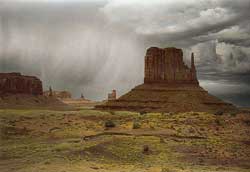 |
 |
Hand-tinted prints by Paul Kozal (clockwise from bottom left): 'Pump House, Napa Valley, California'; 'August Storm'; Miner's Cabin, Alta, Colorado'; 'Canyonlands.' |
 |
 |
|
 |
 |
Hand-tinted prints by Paul Kozal (clockwise from bottom left): 'Pump House, Napa Valley, California'; 'August Storm'; Miner's Cabin, Alta, Colorado'; 'Canyonlands.' |
 |
 |
|
BY JEANNE CLAIRE VAN RYZIN Growing up in the suburbs of Chicago, Paul Kozal fell in love with old postcards of the American West that he picked up on antiquing junkets with his parents. "I like the exaggerated colors of the landscape, the way the scenes transformed you, took you someplace else," he says. But then something happened when Kozal saw the same landscapes in person during family vacations. "They didn't look like the postcards," he says in disappointment. So he became a fine-art photographer who trains his lens on the landscapes and forgotten architecture of the great American West and creates images rich with atmosphere and sentiment. Now, the 37-year-old has built a lovely body of photographic work, a selection of which is showing at Oswald Gallery. Kozal started snapping photos when he inherited the role of family photographer from an older brother. He liked taking pictures but opted for studying business economics in college. After graduation he went to work for a western wear company - a job that, no surprise, sent him out west quite often. He was put in charge of overseeing photo shoots, and again, no surprise, eventually ended up doing the shoots himself. Then, on a a 1989 road trip, it all came together; the beauty of the Western landscape, the sky, the light, the forgotten old buildings and out-of-the way places. And yes, the camera. Since then, Kozal has never stopped taking road trips, some lasting as long as six months. "I don't follow a specific itinerary, I talk to local people about the places they know and I stick to the blue highways - the old back roads," he says, from his home in Sonoma County, California. Kozal rides shotgun while his wife, Carol, drives. And while he may not follow an exact route, he does return to the same handful of locales - the same desert dunes, the same adobe churches - year after year to capture the shifting values of light. Take Las Trampas, the adobe church in New Mexico that he has shot once a year for eight years. "The picture really didn't come together until I saw this large cloud formation above the steeple," he says. "And that was after eight year of photographing the place." He pauses for a moment, then adds with chuckle, "I guess I'm really very patient." After all, for Kozal, it's not about getting the right shot. The reality of nature is just grand, but Kozal finds the mood and feeling of place more intriguing, which is why he works on the developing process so intently. "I'm not out to document a scene necessarily, but to transform it," he explains. He spends a lot of time burning and dodging (darkening and lightening) his prints, toning them with sepia and even coloring them with sepia and even coloring them with transparent inks. And that means that though Kozal publishes his images in editions of 50, every single photograph is unique. The result uncannily resembles those old postcards of his childhood. "Canyonlands," for instance, show a scrappy tree in the foreground of a desert scene with a sierra in the background - almost an Ansel Adams-like vista, except the sierra is nearly baby pink, the tree a strange shade of saffron and the desert grass a nuclear yellow. "Canyonlands" is a sweet, rather nostalgic image of the West. And like all of Kozal's photographs, it is far more than a simple photograph. It's much farther down the road - miles and miles past ordinary. jvanryzin@statesman.com; 445-3699 |
'Paul Kozal'
When: 11 a.m. to 6 p.m. Tuesday-Saturday through Sept. 13
Where: Oswald Gallery, 500 N. Lamar Blvd.
How much: free
Info: 494-9440, www.oswaldgallery.com
Artist's talk/reception: 6-8 p.m. Saturday
On the web: www.paulkozal.com
© Copyright 2003
Paul Kozal